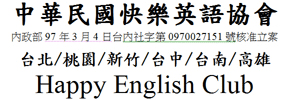#1, 04/28/'07, Speech Topic "Few English Jokes"
#2, 09/01/'07, Speech Topic "Emperior Qin's Terracotta Warrier"
[youtube]http://youtube.com/watch?v=GlBAwR3DXJ8[/youtube]
Emperor Qin's Terracotta Warrior
There were two important museum exhibition, in Taipei, this year. One was the British Museum Collection Display, the other was the Terracotta Army Exhibition. I've been to both of them and was very impressed by the content. Today, I'd like to talk about few interesting observations from my tour to the “Terracotta Army Exhibition”.
I believe you all must have heard about the “Emperor Qin's Terracotta Warrior”. But does any of you know that they were the first free-standing statures in the history of the world art? Although there are many sculptures in ancient Greek & Rome, but those were carved out of a block of marble stone and were stick to the ground. The Terracotta Solders were the first free standing statures in the world history. This may not mean a thing to the current technology, but it was a big challenge 2200 years ago. And, please don't forget, there were made tens of thousand of individual human and animal statures, so the ancient Chinese craftsmen were handling the problem at a mass production scale.
The key to keep the statues standing were to lower the center of gravity and enlarge the base area. Elementary Physics tells us, as long as the center of gravity stay within the base area, the object will not fall down. So lowering the center of gravity and enlarging the base area was a correct approach. However, the ratio of human body & animal body were pretty much fixed, the craftsmen could not make the solder's head as small as that of a monkey and make a giant leg like an elephant. So how did they solve this perplexing problem? I've got the answer during the tour. The terracotta solder's legs were solid, but their bodies, arms and heads were hollow. Same design was applied to horses too. So the upper half would have less weight and the lower half would be heavier. There was another smart design. Have you noticed that all standing statures have a rectangular stage underneath their feet. That's for the purpose of enlarging the base area. Those two designs helped to make the statures stand firmly.
The next question is how they produced the statues? Making a hollow object at such a big size was not an easy task. Archeology investigation found the ancient Chinese craftsmen had started using the mold. They pulled fine clay into modes & made rough shape of bodies, arms & heads. Those pieces were then stick together. Following that, the craftsmen carved the feature details onto the soft clay. At the end, the assembled figures were fired at a high temperature. This process was actually a mass scale assembly production, plus it incorporated the tailor made flexibility as each stature came out with unique feature. Remember, we are talking about more than 8000 warriors, 200 horses, plus birds and some other animals, all life-size, and none of them was identical to each other. Isn't it amazing !!
The other interesting observation was that, the statures were standing on bricks, not on the earth. All those terracotta warriors & horses were buried in the underground pits. Each pit was constructed with many corridors where the terracotta statures were located. I noticed those corridors, separated by earth walls, were paved with pottery bricks. The statures were actually standing on those bricks. Those pottery bricks definitely formed a smoother surface and were more resistant to environment changes, for example, underground water flow or soil drifting. All those design were helpful to maintain the stability of the standing statues.
After this tour, I've learned a lot of details. Although I've read the “Emperor Qin's Terracotta Army” from the textbook before, but I've never got a chance to think about those questions, such as, how they manufactured so many units? how they kept them from damaging? how they arranged such a large scale operation? It's quite exciting to learn these knowledge. I am also pleased to share them with you. Hopefully, one day I will get a chance to visit the actual site of Emperor Qin's mausoleum in Xi'an.
Thank you for your patience. I will be happy to take some questions, but please be simple, not too hard. Thank you !!
- End -
20070901, Speaker--Golden Chiang


[/url]







